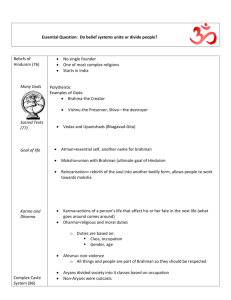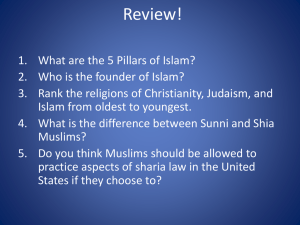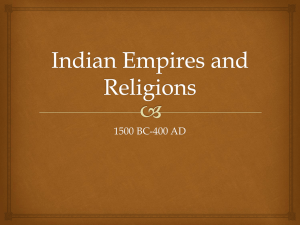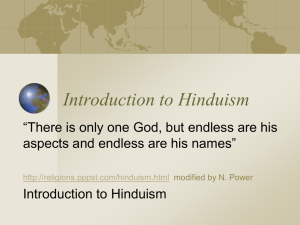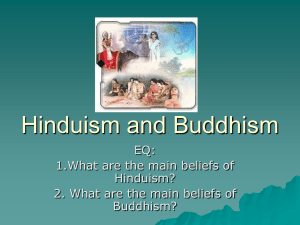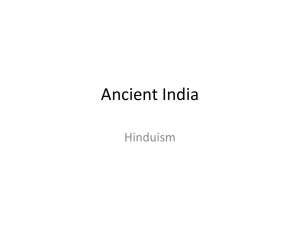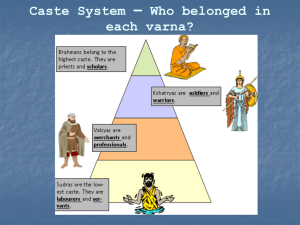India - Continued
advertisement
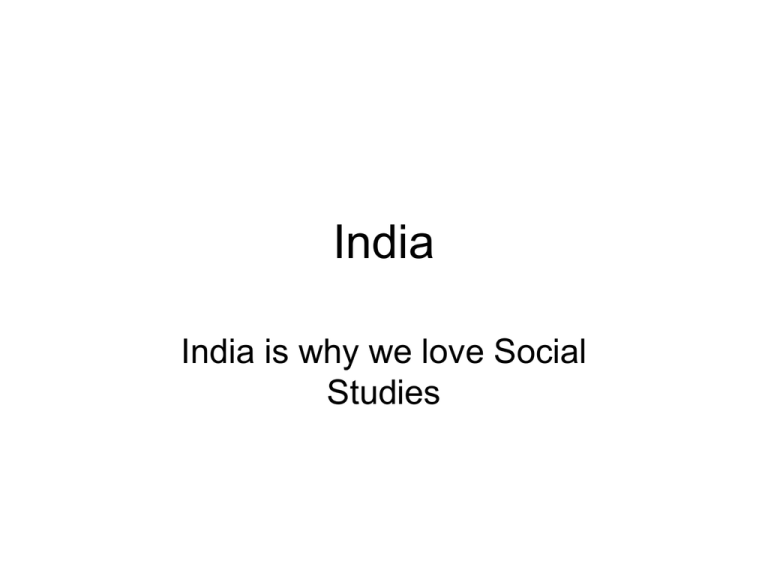
India India is why we love Social Studies Chapter 3.3 &3.2: Empires of India • Hinduism and Buddhism – The Beliefs of Hinduism – No single founder or no single sacred texts like most major religions » Probably happened slowly over time and began when the Aryans added the gods of the Indus people to their own gods » More gods added later making Hinduism very complex with countless gods and goddesses and many forms of worship » Still, all Hindus share certain basic beliefs Many Gods – or One? All of the universe is part of the unchanging, all-powerful spiritual force called Brahman Brahman is too complex a force for most people to understand, so they worship a variety of gods that give a concrete form to Brahman Most important gods Brama, the Creator Vishnu, the Preserver Shiva, the Destroyer All gods can take many forms human or animal, and also has his own family Sacred Texts Hindu teachings were recorded over several thousand years in the Vedas and Upanishads The Bhagavad-Gita spells out many ethical ideas central to Hinduism…duty over personal desires The Goal of Life Every person has an essential self or atman (another name for Brahman) The ultimate goal of existence is achieving moksha or unison with Brahman A person must free themselves from selfish desires that separate them from Brahman…cannot do this in one lifetime Reincarnation is the rebirth of the soul into another bodily form and allows people to continue working toward moksha through several lifetimes Karma and Dharma Can come closer to moksha by obeying the law of karma Karma is the actions of a person’s life that affect his or her fate in the next life Hindus rank all existence Humans are closest to Brahman Then, animals, plants, and objects like rocks and water If you live a virtuous life, you are reborn at a higher level of existence If you do evil, you acquire bad karma and are reborn into suffering Endless cycle of rebirth is symbolized by the image of the wheel in Indian art Dharma » Dharma is the religious and moral duties of an individual » These duties vary according to class, occupation, gender, or age » By obeying dharma, a person acquires merit for the next life » Escape the wheel of fate by following dharma » The concepts of dharma and karma helped ensure the social order by supporting the caste system » Another key moral principle of Hinduism is ahimsa (uh HIM sah) or nonviolence » All people and things are aspects of Brahman and should be respected » Many holy people have tried to follow the path of nonviolence – Opposition to the Brahmins » 500 BC Mahavira (muh hah VEE ruh) founded Jainism (JIN ihz um), a new religion that grew out of Hindu traditions » Rejected the idea that Brahmin priests alone could perform certain sacred rites » Emphasized meditation, selfdenial and an extreme form of ahimsa » To avoid accidentally killing even an insect, Jains carried brooms to sweep the ground in front of their feet – Gautama Buddha: The Enlightened One – Siddhartha Gautama…beliefs eventually spread through Asia to become the core beliefs of one of the world’s most influential religions – Early Life » Born about 566 BC to a high-caste family » Prophet said because of mother’s dream, that he would someday become a wandering holy man » Father kept him in the palace surrounded by comfort and luxury…he married, had a son, and lived a happy life – The Search » Rode beyond the palace wall one day and saw a sick person, an old person, and a dead person » For the first time, he became aware of human suffering » Said goodbye to his wife and set out to find “the realm of life where there is neither suffering nor death” »Wandered for years seeking answers from Hindu scholars and holy men…fasted and meditated »Stayed under a giant tree, determined to stay there until he understood the mystery of life »For 48 days, evil spirits tempted him to give up his meditations »Finally, he arose as Buddha, the “Enlightened One” The Four Noble Truths • 1. Life means suffering • 2. The origin of suffering is attachment • 3. The cessation of suffering is attainable • 4. The path to the cessation of suffering – Four Noble Truths » Spent the rest of his life teaching others what he had learned » In his first sermon, he explained the four noble truths that lay at the heart of Buddhism » All life is full of suffering, pain and sorrow » The cause of suffering is the desire for things that are really illusions, such as riches, power, and long life » The only cure for suffering is to overcome desire » The way to overcome desire is to » The Eightfold Path was right views, right aspirations, right speech, right conduct, right livelihood, right effort, right mindfulness, and right contemplation » The first two steps involved understanding the Four Noble Truths and committing oneself to the Eightfold Path »Next, a person had to live a moral life, avoiding evil words and actions »Through meditation, a person might at last achieve enlightenment »The final goal is nirvana, union with the universe and release from the cycle of rebirth • The Buddha saw the Eightfold Path as a middle way between a life devoted to pleasure and one based on semidenial…stressed moral principles such as honesty, charity, and kindness to all living creatures – Buddhism and Hinduism Compared » Both stressed nonviolence and believed in karma, dharma, moksha, and a cycle of rebirth » Differed in several ways » Buddha rejected the priests, formal rituals, and many gods of Hinduism…urged each person to seek enlightenment through meditation » Buddhists rejected the caste system offering the hope of nirvana to all regardless of birth Spread of Buddhism Many were attracted to Buddhism Set up monasteries and convents for meditation and study…some became major centers of learning Death is clouded in legend…at age 80 supposedly ate spoiled food and gave advice to work out salvation with diligence – Sacred Texts » Works collected into a sacred text called the Tripitaka or “Three Baskets of Wisdom” » Example of one of the “baskets” includes Hindu emphasis on duty or the Buddhist version of the Golden Rule – Two Sects » Missionaries and traders spread Buddhism across India to many parts of Asia » Buddhism split into two major sects or smaller groups called Theravada (ther uh VAH duh) Buddhism and Mahayana (mah huh YAH nuh) Buddhism • » Theravada is close to Buddha’s original teachings and required a life devoted to hard spiritual work » Only dedicated seekers, like monks and nuns, could hope for nirvana » Spread to Sri Lanka and Southeast Asia » Mahayana made Buddhism easier for ordinary people to follow Even though Buddha had forbidden followers to worship him, they pictured him and other holy beings as compassionate gods for help in solving daily problems as well as achieving salvation » Buddha had said little about the nature of nirvana, but the Mahayana described an afterlife filled with many heavens and hells » Spread to China, Tibet, Korea, and Japan – Decline in India » Buddhism slowly declined in India » Hinduism eventually absorbed some Buddhist ideas and made room for Buddha as another Hindu gods » A few Buddhist centers survived until the 1100s when they fell to Muslim armies that invaded India Pillars of Indian Life • The Complex Caste System – Complex Rules » Castes were linked to Hindu beliefs…higher castes were purer and closer to moksha than someone form a lower caste » Web of complex rules governed every aspect of life » Where people lived, what they ate, how they dressed, and how they earned a living » Rules forbade marrying outside one’s caste or eating with members of another caste » High caste people had the strictest rules to protect them from the spiritually polluted, or impure lower castes » For the lowest-ranked outcastes, ro “Untouchables”, life was harsh and restricted » Impure jobs such as digging graves, cleaning streets, or turning animal hides into leather » Other castes feared that contact with the “Untouchables” could spread pollution » Untouchables had to live apart and sound a wooden clapper to warn of their approach » Despite inequalities, caste ensured a stable social order » People believed that the law of karma determined their caste » While they could not change their status in this life, they could reach a higher state in a future life by faithfully fulfilling the duties of their present caste » Caste system gave people a sense of identity and interdependence » Each caste had its own occupation and its own leaders » Caste members cooperated to help one another » Each caste had its own special role in Indian society as a whole » Although separated, different castes depended on one another for their basic needs…carpenter built house of a scholar » Caste system also adapted to changing conditions absorbing foreigners and new occupations into their own castes Family Life » Ideal family was the joint family in which parents, children, grandchildren, uncles, and their offspring shared a common dwelling » Only achieved by the wealthy because others did not live long enough » Still, close ties linked brothers, uncles, cousins, and nephews » Indian family was patriarchal…father headed the household » Enjoyed great authority » Still, power was limited by sacred laws and traditions and he usually made decisions after consulting his wife and other family members » Property belonged to the whole family Children and Parents » From an early age, children learned their family duties which included obeying caste rules » Family interests came before individual wishes » Children worked in the fields with older relatives or at a family trade » Daughter learned at an early age that she would have to serve and obey her husband’s family » A son learned the rituals to honor the family’s ancestors…deepened family bonds through the generations » Parents had to arrange a good marriage for their children based on caste and family interests » Marriage customs varied » In Northern India, a bride’s family provided a dowry or payment to the bridegroom and financed the wedding festivities » After marriage, the daughter left her home and became part of her husband’s family


